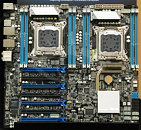- Joined
- Oct 9, 2007
- Messages
- 47,878 (7.38/day)
- Location
- Dublin, Ireland
| System Name | RBMK-1000 |
|---|---|
| Processor | AMD Ryzen 7 5700G |
| Motherboard | Gigabyte B550 AORUS Elite V2 |
| Cooling | DeepCool Gammax L240 V2 |
| Memory | 2x 16GB DDR4-3200 |
| Video Card(s) | Galax RTX 4070 Ti EX |
| Storage | Samsung 990 1TB |
| Display(s) | BenQ 1440p 60 Hz 27-inch |
| Case | Corsair Carbide 100R |
| Audio Device(s) | ASUS SupremeFX S1220A |
| Power Supply | Cooler Master MWE Gold 650W |
| Mouse | ASUS ROG Strix Impact |
| Keyboard | Gamdias Hermes E2 |
| Software | Windows 11 Pro |
ASUS' dual-LGA2011 workstation motherboard, the Z9PE-D8-WS, has been listed by Canadian retailer NCIX for pre-order. It is priced at CA $632.98 (US $634.56). The store page does not go on to mention availability, except that orders will be shipped whenever there are inventories. Given its pre-order listing, we expect the product-launch of the Z9PE-D8-WS not to be too far, considering Intel's launch of a large number of "Sandy Bridge-EP" Xeon processors is just around the corner (within Q1, 2012). The Z9PE-D8-WS is designed to support 2P configurations based on Xeon "Sandy Bridge-EP" processors. The motherboard is further detailed here. To PC enthusiasts, it presents a potential alternative to EVGA's SR-X.

Image Courtesy: VR-Zone
View at TechPowerUp Main Site

Image Courtesy: VR-Zone
View at TechPowerUp Main Site






